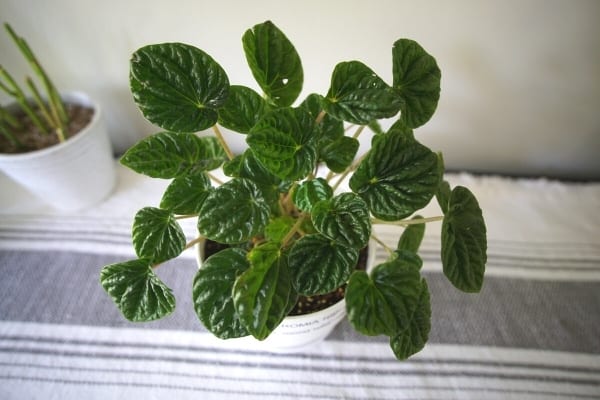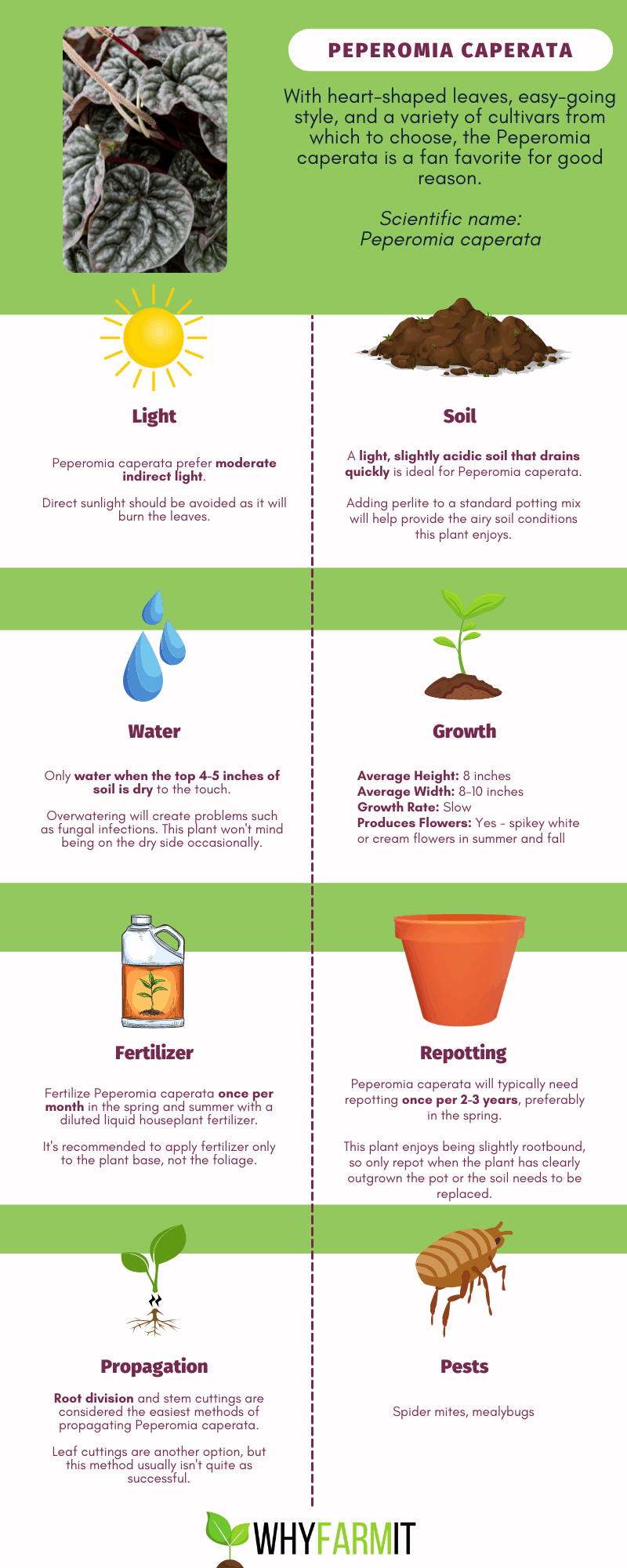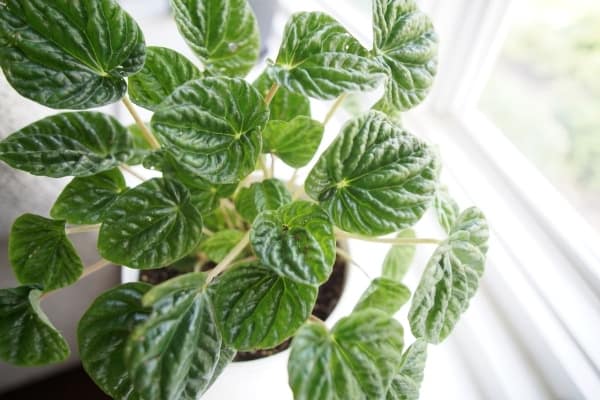The Emerald Ripple Peperomia, also recognized as Peperomia caperata, originates from the depths of the South American jungles.
This epiphytic plant has increased in popularity and, because of this newfound fame, it has found itself a new habitat in the homes and office spaces of plant lovers across the globe.
Its uniquely shaped arrow-like flowers accentuate its fleshy deep green leaves and purplish stems, making it the next must-have plant for gardeners everywhere.
How do you care for Peperomia caperata? The Peperomia caperata prefers moderately acidic soil that drains quickly. Keep the plant in shade or indirect light. Water sparingly to maintain slightly moist soil. Ensure the temperature range is 65-75℉ (18-24℃). Fertilize once a month in the spring and summer with diluted fertilizer.
Caring for Peperomia Caperata: Basic Guidelines
The above table summarizes the various points we will discuss to ensure that your Peperomia caperata receives the appropriate balance of nutrition and care throughout its life.
The following is a comprehensive guide that will equip you with the knowledge and tools necessary to keep your Peperomia caperata healthy and flourishing.
Additionally, our helpful hints and frequently asked questions sections will provide you with precise instructions on how to care for your brand new Peperomia caperata.
Complete Care Guide for Peperomia Caperata
The Peperomia caperata is popular among plant lovers because of its heart-shaped leaves in various colors such as red, green, and even silver.
The Peperomia caperata is a subtropical plant that loves warm, low-light environments.
This epiphytic (nonparasitic) plant is often found growing on other plants or trees rather than in the soil.
It derives its moisture and nutrients from the air and surrounding organic matter. These plants are great for beginners because they are so easy to grow.
Peperomia Caperata at a Glance
- Scientific Name: Peperomia caperata
- Plant Type: Subtropical
- Average Height: 8 inches (20 cm)
- Average Width: 8-10 inches (20-25 cm)
- Growth Rate: Slow
- Produces Flowers: Yes
- Common Pests: Spider mites, mealybugs
- Level of Care: Low maintenance
What To Do When You First Get Your Peperomia Caperata
Ensure your new Peperomia caperata is in a suitable container with enough drainage holes to prevent water from pooling at the bottom.
Position the plant in a bright room out of direct sunlight and cold drafts.
Ideal Soil for Peperomia Caperata
The Peperomia caperata enjoys slightly acidic soil with a pH of 6.0- 6.6.
Because this plant is epiphytic, it is used to growing in very little soil and enjoys light, airy potting soil.
Mix perlite into regular potting soil to achieve a light soil mixture.
Peperomia Caperata Water Requirements
Overwatering is a common mistake when watering the Peperomia caperata.
Use the touch test to check that the top 4-5 inches (10-12 cm) of soil is completely dry before watering again.
Peperomia Caperata Lighting Needs
The Peperomia caperata thrives in the shady areas of its natural forest habitat.
While this exact lighting can’t always be achieved in the home, it’s best to keep this plant out of direct sunlight to prevent the leaves from burning.
Ideal Temperature Range for Peperomia Caperata
Peperomia caperata does not do well in temperatures below 59℉ (15℃). The optimum temperature range for this plant is 65-75℉ (18-24℃).
In cooler climates, it’s best to grow this plant in a container that can be brought indoors during the winter.
Ideal Humidity Level for Peperomia Caperata
These plants love the high humidity levels found in their natural habitat but do well in humidity levels of about 40%-50%.
Don’t place the plant near the central heating or air conditioning as this will cause them to dry out. To increase humidity levels, grow your plant in a glass jar without a lid.
Best Location for Peperomia Caperata
Humidity and lighting are key factors in the placement of the Peperomia caperata.
Therefore, any environment that provides humidity and lighting levels similar to the plant’s natural habitat will be ideal, such as a greenhouse, bathroom, kitchen, or terrarium.
Peperomia Caperata Growth Habits
The Peperomia caperata has a relatively chilled approach to growing.
On average, this slow-growing plant can reach a height and width of 8 inches (20 cm) when fully grown.
Fertilization Type & Schedule for Peperomia Caperata
Peperomia caperata prefer a lighter diet than most house plants and only require feeding once monthly in the spring and summer.
A diluted liquid houseplant fertilizer can easily be applied to the roots and surrounding plant base.
Signs of Nutrient Deficiency
Yellowing leaves are a sure sign of nutrient deficiency. Apply a diluted or light fertilizer to improve the soil’s nutrient levels.
Use rainwater to mist the plant as the Peperomia caperata draws nutrients and water from the air.
The use of slow-release organic manure can also be helpful in mature plants with nutrient deficiency.
Pruning Peperomia Caperata
Pruning is not really a requirement as this plant naturally grows on the bushier side.
However, light pruning of dead or damaged leaves is required to keep the plant healthy and looking its best.
Does Peperomia Caperata Produce Flowers? 
The Peperomia caperata produces flowers in the summer and autumn. These flowers are white or cream in color and spiked in shape.
Is Peperomia Caperata Toxic?
This friendly plant is nontoxic to people, dogs, cats, and horses.
Peperomia Caperata Propagation
The easiest way to propagate the Peperomia caperata is by using stem cuttings. Some gardeners use leaf cuttings, but these are not as successful.
You can also separate the tiny plantlets that grow around the mother plant’s base, which can be done when repotting the plant.
The optimum time to propagate this plant is during the growing season.
Propagating the Peperomia Caperata Using Stem Cuttings
This is the most typical way of propagating the Peperomia caperata. This method can be done using soil or water.
The tools required are a pair of clean, sterilized scissors or a knife, gardening gloves, a clean jar, and some freshwater or soil.
You can either use rubbing alcohol to sterilize the scissors or pass the blades through a candle flame.
1. Snip a Healthy 3 Inch Stem From the Main Plant
Using your scissors, snip a healthy stem off the main plant. The stem should be approximately 3 inches (7 cm) long and have about three to five leaves on it.
2. Place the Stem on a Paper Towel and Allow To Dry
Gently place the cutting onto some paper towels, and allow it to dry for two to three days.
3. Place the Cutting in Warm Water or Moist Soil
The cutting can be placed into a jar of clean room temperature water or directly into moist soil.
If you are using soil to propagate the cutting, use a soil mix of 50% peat and 50% perlite.
Cover the plant using a clear plastic bag creating mini-greenhouse conditions. Open the bag once a week for fresh air.
4. Position the Cutting in a Warm Area in Semi Shade.
Position the cutting in a warm area away from cold drafts and ensure it receives plenty of indirect sunlight.
If using water to propagate the cutting, ensure the water remains at room temperature consistently.
5. Transfer the Rooted Plant to a New Container With Fresh Soil
In ideal conditions, rooting can take four to eight weeks. Once the plant has produced a healthy root system, it is ready to be transplanted into a new container filled with fresh soil.
Adhere to the standard care instructions for mature Peperomia caperata.
Propagating the Peperomia Caperata by Division
The main plant will sprout small plantlets at its base. Once they have grown to a suitable size, you can separate them from the main plant.
This method is best done when repotting the main plant.
1. Check the Base of the Main Plant for Plantlets
Carefully inspect the base of the main plant for healthy new plantlets, being careful not to damage surrounding foliage.
2. Remove the Main Plant From the Plant Pot
Gently empty the plant out of its container into your hand so that the roots are exposed and easy to inspect. Brush away any excess soil.
3. Use your Fingers to Detangle the Roots
Using your fingers to detangle the bunched and twisted roots, being careful not to snap any roots off in the process.
4. Separate One or More Stems From the Main Plant
Take a stem and trace it down to the roots. You may divide the section into one or more sections depending on the size of the plant.
5. Place Each Section in Its Own Container and Water Thoroughly
Half fill some containers with a mix of regular potting soil and perlite. Place each new section into its own container and fill up the remainder of the container with soil.
Water the plant thoroughly, and follow the care instructions for a mature Peperomia caperata.
Repotting Peperomia Caperata
Repotting is best performed in the spring but should only be done when the plant has outgrown its container as the Peperomia caperata likes being slightly rootbound.
When To Repot Peperomia Caperata
Any time you notice a significant drop in growth, leaf discoloration, rootbound conditions, or soil that exhibits signs of being worn out, it’s time for a new pot and fresh soil.
However, repotting should only be done when necessary.
The Peperomia caperata is adapted to growing in small spaces and thrives when its roots are slightly restricted. Typically, repotting is required every two to three years.
Signs That It’s Time To Repot
- Yellowing leaves
- Soil that is unable to retain moisture
- Roots peeping through the drainage holes of the container
- Frequent watering required
How To Repot Peperomia Caperata
To successfully repot your Peperomia caperata, you will need the following tools: gloves for gardening, a new container, new potting mix, and water.
1. Choose a Pot One Size Bigger Than the One Currently in Use
The Peperomia caperata prefers a close-fitting container for its roots.
2. Gently Tip the Plant Out of Its Container Into Your Hand
Using your fingers, loosen the roots and the potting mix that surrounds them. Avoid damaging roots or tugging excessively hard.
3. Fill the Container Halfway With New Moist Potting Soil.
Make a fist-sized indentation in the soil and insert the root ball.
Fill the container with potting soil until the roots are completely covered and the container is full. Firmly pack the soil around the plant’s base.
4. Water Thoroughly and Maintain a Moist Soil Environment.
Thoroughly water, ensuring that any excess water drains well.
Peperomia Caperata Common Problems & Solutions That Work
Peperomia Caperata Common Pests
The Peperomia caperata rarely succumbs to pests. However, it can occasionally be troubled by common plant pests.
Continue reading to learn how some simple solutions can help you get your plant back into tip-top shape.
Spider Mites
Signs of Trouble
Red spider mites will leave webs all over the plant. You may find tiny brown dots caused by the spiders nibbling on the foliage.
Solution
To 1 gallon of water, add 2 tablespoons of neem oil. Personally, I prefer this organic neem and always have great results with it.
Spray the solution liberally over the entire plant, paying special attention to the lower surface of the leaves.
To eradicate infestations, spray continuously for seven days.
Prevention
Spray the plant every two weeks to prevent spider mites. Inspect the plant often for early signs of infestation.
Mealybugs
Signs of Trouble
Leaves start to wilt and turn yellow. Fluffy white spots appear on the leaves; these are mealybugs.
Solution
Combine 1/2 teaspoon neem oil with some natural soap (soap-nut liquid). Half fill a reusable spray bottle with water, and add the solution.
Spray the solution liberally over the entire plant, concentrating on mealybug-infested areas first.
Prevention
Before planting, inspect new plants and cuttings for signs of mealybug.
Continue to regularly inspect your plants for signs of mealybugs, and treat them immediately to prevent their population from growing.
Peperomia Caperata Common Diseases
This is not a disease-prone plant, but even hardy plants are not infallible to disease.
Ring Spot
Signs of Trouble
Leaves develop round ring-shaped spots.
Solution
Trim infected leaves and reduce humidity. Place the plant where air can circulate easily to dry excess moisture on the leaves. There is no official treatment for this disease.
Prevention
Keep humidity and moisture levels balanced. Remove infected leaves immediately to prevent the disease from spreading.
Phyllosticta Leaf Spot
Signs of Trouble
Leaves develop gray lesions in oval patterns. The lesions increase in size and leave holes in the foliage, with leaves eventually turning yellow and falling off.
Solution
Isolate the plant to stop the disease from spreading. Trim and dispose of infected leaves. Fungicides are not advised to treat this form of leaf disease.
Prevention
Maintain a healthy balance of humidity and moisture. Eliminate infected leaves immediately to prevent the spread of the disease.
Phyllosticta leaf spot spreads in cool, moist conditions. Therefore you should ensure there is adequate air circulation to aid in the drying of leaves.
Other Common Problems
Peperomia caperata is a relatively easy-going species that rarely has health problems.
However, some pretty common issues do arise that can be resolved with patience and continued care.
Brown Leaves
Signs of Trouble
Brown leaves can be a sign of numerous problems, but the most common reason is the use of tap water.
Peperomia caperata is sensitive to chlorine and fluoride found in tap water.
Solution
Trim damaged leaves, and review the watering method.
Prevention
Use distilled water or rainwater when watering. Alternatively, allow tap water to stand for 24 hours before use.
Peperomia Caperata Common Questions

My Ripple Peperomia. I just love the 3D look of the leaves!
How Much Does a Peperomia Caperata Cost?
This is one of the cheaper variations costing between $3-$5 in most cases.
Is Peperomia Caperata the Same as Emerald Ripple Peperomia?
Emerald Ripple Peperomia is another name for Peperomia caperata.
How Many Types of Peperomia Caperata Are There?
While the Peromia genus contains more than 1,500 different species, Peperomia caperata specifically has fewer cultivars.
Some of the most popular varieties include the ‘Emerald Ripple’, ‘Suzanne’, ‘Moonlight’, ‘Luna Red’, ‘Harmony’s Mightnight Wave’, ‘Rosso’ (pictured above), ‘Steve’s Leaves Chameleon’, and ‘Pink Lady’.
What Colors Do Peperomia Caperata Plants Come In?
Peperomia caperata has heart-shaped leaves ranging from green to deep purple to a lighter shade of pink or red.
What Is a Radiator Plant?
Radiator plant is the common name given to Peperomia caperata as they thrive in warm environments.
Do All Peperomias Vine?
Not all Peperomia are vining plants. Peperomia prostrata is a variation of Peperomia that produces vines.
Is Peperomia Caperata a Succulent?
The Peperomia caperata has succulent-like features as it is quite fleshy and holds water, but unlike a succulent, it cannot withstand dry conditions for long periods.
Should I Mist Peperomia Caperata?
This plant enjoys misting, or you can use a damp cloth to moisten the leaves and remove dust.
Should I Bottom Water an Emerald Ripple Plant?
Bottom watering will leave the roots standing in excess water, leading to possible root rot.
How Do You Make a Peperomia Caperata Bushy?
The Peperomia caperata is naturally bushy. However, trimming dead leaves will encourage fuller growth.
Why Is My Emerald Ripple Peperomia Leggy?
Insufficient sunlight can cause the plant to become leggy.
Why Are Leaves Falling Off My Emerald Ripple Peperomia?
Peperomia leaves that fall off are commonly caused by excessive watering, as damaged roots are unable to distribute moisture and nutrients to the plant.
5 Key Tips for Success With Peperomia Caperata
- Avoid overhead watering as this can cause leaf disease.
- Use a terracotta plant container to allow roots to dry between watering.
- Ensure the Peperomia caperata is positioned in bright indirect light.
- Position the plant on a pebble tray filled with water to increase humidity levels for the plant.
- Fertilize with diluted liquid fertilizer in the summer months only.
Conclusion
This subtropical plant is low maintenance and easy to grow.
We are confident that if you follow the simple guidelines we have provided, you will agree that the Peperomia caperata is an excellent addition to your garden or home.


